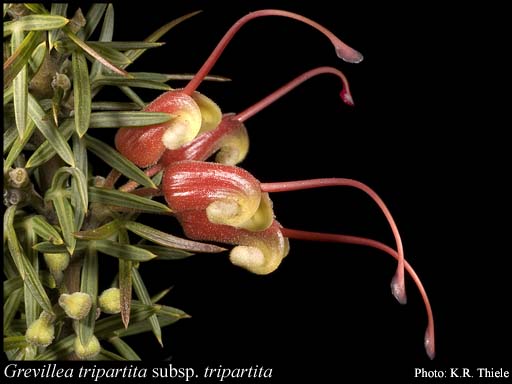- Conservation Code
- Not threatened
- Naturalised Status
- Native to Western Australia
- Name Status
- Current
Erect, spreading shrub, 0.8-1.3 m high, distinguished from Grevillea tripartita subsp. macrostylis on limited foliar features. Fl. red-orange, May to Dec. White sand, gravelly loam, sand or clay over laterite. Gentle slopes, near small salt lakes.

Scientific Description
Shrubs, 1-3 m high; branchlets hairy, not glaucous. Leaves alternate, 10-50 mm long, hairy, on the adaxial or abaxial surface, the hairs straight; lamina flat, once divided, tripartitely divided, divided to the midrib; lobes 5-20 mm long, 2-5 mm wide, the margins revolute, enclosing the lower surface of the leaf blade, forming a groove either side of the midvein. Inflorescences terminal, orange or red; pedicels (7-)8-10 mm long. Perianth 15-20 mm long; tepals all free after flower opens, hairy, glandular-hairy; ovary glabrous, stipitate, the stipe 1.5-3 mm long; pistil 40-45 mm long, orange or red, pollen presenter lateral, style glabrous. Follicles glabrous, not viscid, dehiscent, 12-18 mm long. Flowers in May, June, July, August, September, October, November or December. Occurs in the South-west (SW) Botanical Province(s), in the Mallee (MAL) or Esperance Plains (ESP) IBRA subregion(s).
Distribution
- IBRA Regions
- Esperance Plains, Mallee.
- IBRA Subregions
- Fitzgerald, Western Mallee.
- Local Government Areas (LGAs)
- Albany, Jerramungup, Kent, Lake Grace, Plantagenet, Ravensthorpe.